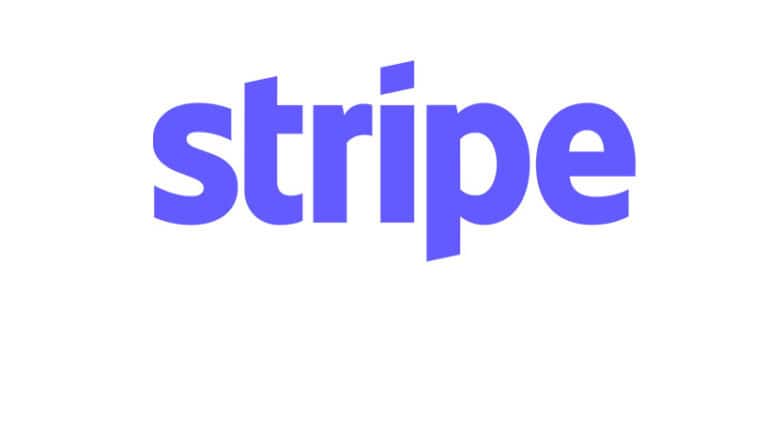Introduction
Cracking a FAANG interview is the dream of every software engineer. Why? Because FAANG companies (Facebook, Amazon, Apple, Netflix, and Google) are the pinnacle of innovation, offering unparalleled career growth, cutting-edge projects, and jaw-dropping perks. But let’s be real—landing a job at one of these tech giants is no walk in the park. That’s why it’s crucial to prepare effectively for Unlocking FAANG Success
FAANG interviews are notorious for their rigor. They test not just your technical skills but also your problem-solving ability, creativity, and cultural fit. The competition is fierce, and the stakes are high. But here’s the good news: with the right preparation and strategy, you can crack the code to FAANG success.
At , we’ve helped countless software engineers ace their FAANG interviews. In this blog, we’ll share everything you need to know—key coding questions, proven strategies, and insider tips—to help you stand out in your next FAANG interview. Let’s get started!
Why FAANG Interviews Are Different
FAANG interviews are in a league of their own. Here’s why:
High Competition: Thousands of talented engineers apply for a handful of roles.
Rigorous Coding Rounds: You’ll face 1-2 coding rounds where you’ll solve complex problems under time pressure.
System Design: You’ll need to design scalable systems, even for entry-level roles.
Behavioral Interviews: FAANG companies care deeply about cultural fit and teamwork.
The bottom line? You need to bring your A-game.
Understanding the FAANG Interview Process
Before diving into preparation, let’s break down the FAANG interview process:
Phone Screen: A quick coding round to assess basic problem-solving skills.
Coding Rounds: 1-2 rounds where you’ll solve medium to hard-level coding problems.
System Design Round: Design a scalable system (e.g., a chat app or a recommendation engine).
Behavioral Round: Answer questions about your past experiences and teamwork skills.
Each stage tests a different skill set, and you’ll need to prepare accordingly.
Key Coding Concepts You Must Master
FAANG coding interviews focus on a few core areas:
Data Structures: Arrays, Linked Lists, Trees, Graphs, HashMaps, etc.
Algorithms: Sorting, Searching, Dynamic Programming, Greedy Algorithms, etc.
Problem-Solving Patterns: Sliding Window, Two Pointers, BFS/DFS, etc.
Mastering these concepts is non-negotiable. Let’s dive into the top 20 coding questions you’re likely to face in a FAANG interview.
Top 20 Coding Questions Asked in FAANG Interviews
Here’s a curated list of the most frequently asked coding questions at FAANG companies. For each question, we’ll provide:
The problem statement
An approach to solve it
Sample code (in Python)
Time and space complexity analysis
1. Two Sum
Problem: Given an array of integers nums and an integer target, return indices of the two numbers such that they add up to target.
Approach: Use a hash map to store the difference between the target and each element.
Solution:

Complexity: Time - O(n), Space - O(n)
2. Merge Intervals
Problem: Given a list of intervals, merge all overlapping intervals.
Approach: Sort the intervals and merge overlapping ones.
Solution:

Complexity: Time - O(n log n), Space - O(n)
3. Longest Substring Without Repeating Characters
Problem: Find the length of the longest substring without repeating characters.
Approach: Use a sliding window with a hash set.
Solution:

Complexity: Time - O(n), Space - O(min(m, n))
4. Trapping Rain Water
Problem: Given an elevation map, compute how much water it can trap after raining.
Approach: Use two pointers to track the left and right max heights.
Solution:

Complexity: Time - O(n), Space - O(1)
5. Valid Parentheses
Problem: Given a string containing just the characters (, ), {, }, [, and ], determine if the input string is valid.
Approach: Use a stack to match opening and closing brackets.
Solution:
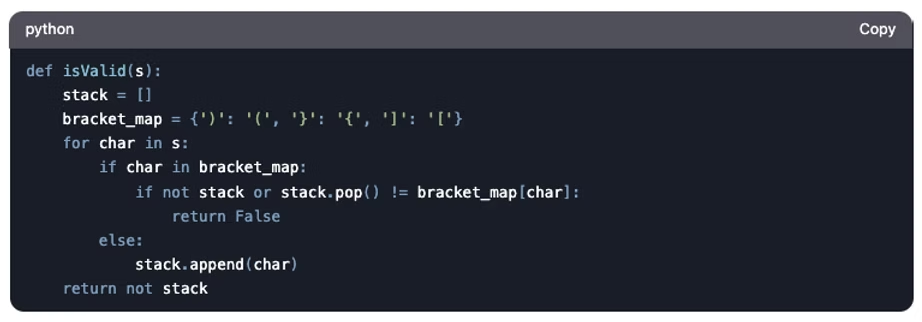
Complexity: Time - O(n), Space - O(n)
6. Maximum Subarray
Problem: Find the contiguous subarray with the largest sum.
Approach: Use Kadane’s algorithm.
Solution:

Complexity: Time - O(n), Space - O(1)
7. Reverse Linked List
Problem: Reverse a singly linked list.
Approach: Use three pointers to reverse the links.
Solution:
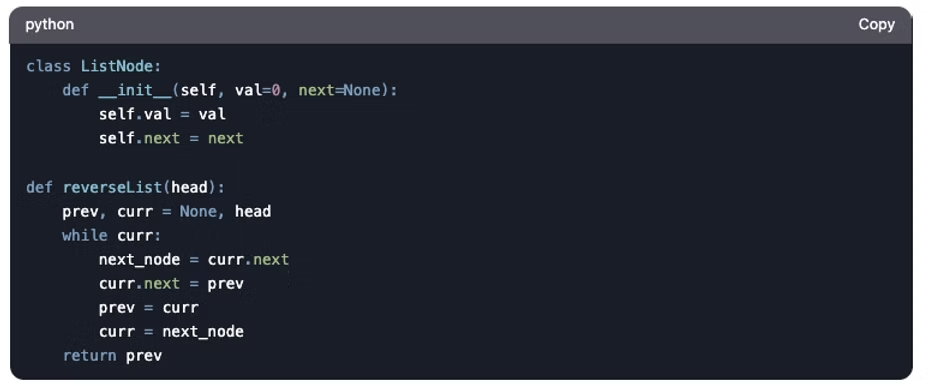
Complexity: Time - O(n), Space - O(1)
8. Clone Graph
Problem: Clone a connected undirected graph.
Approach: Use DFS and a hash map to store cloned nodes.
Solution:
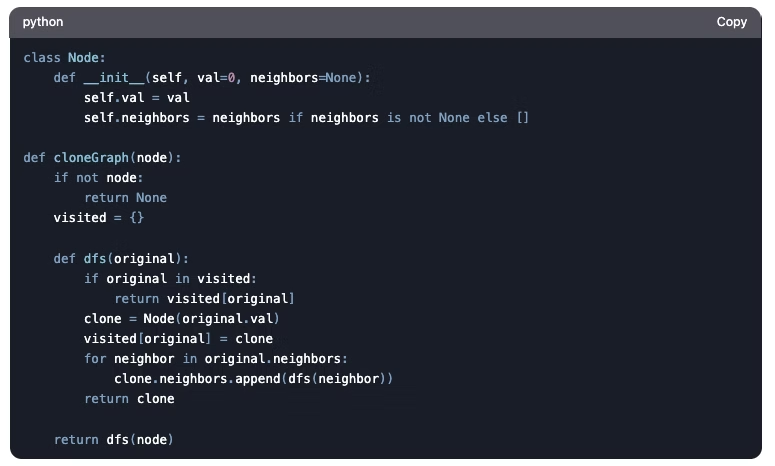
Complexity: Time - O(n), Space - O(n)
9. Word Break
Problem: Given a string and a dictionary of words, determine if the string can be segmented into a space-separated sequence of dictionary words.
Approach: Use dynamic programming.
Solution:
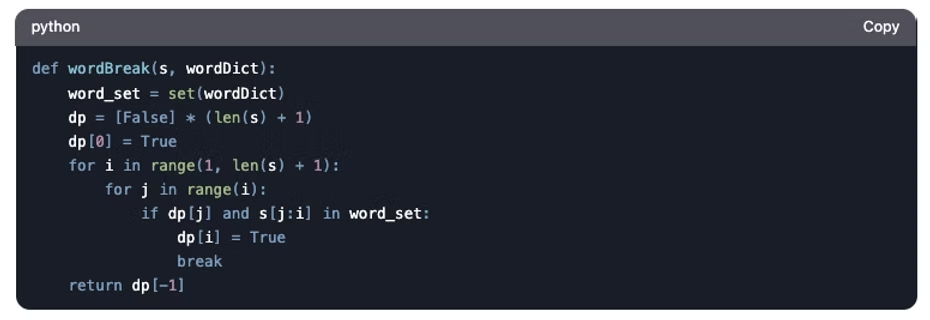
Complexity: Time - O(n^2), Space - O(n)
10. LRU Cache
Problem: Design a Least Recently Used (LRU) cache.
Approach: Use a hash map and a doubly linked list.
Solution:

Complexity: Time - O(1), Space - O(n)
11. Merge k Sorted Lists
Problem: Merge k sorted linked lists into one sorted linked list.
Approach: Use a min-heap to efficiently merge the lists.
Solution:

Complexity: Time - O(n log k), Space - O(k)
12. Find Median from Data Stream
Problem: Design a data structure that supports adding integers and finding the median.
Approach: Use two heaps (min-heap and max-heap).
Solution:
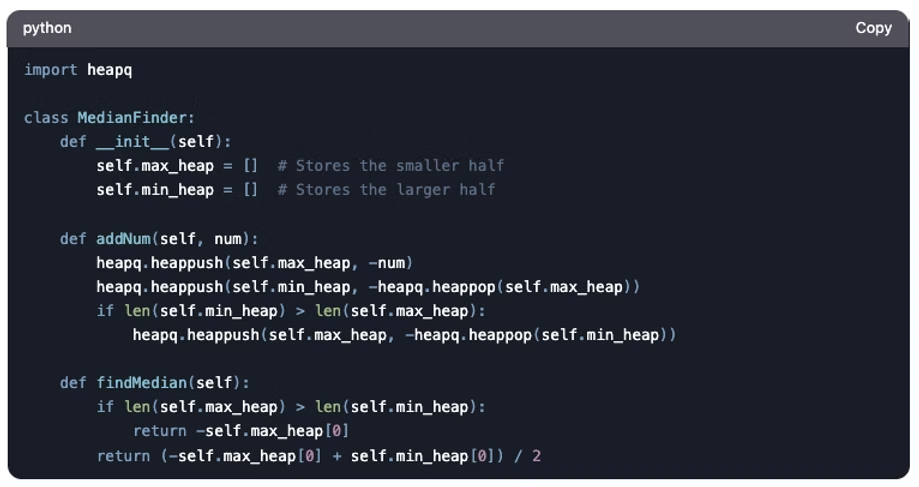
Complexity: Time - O(log n) for addNum, O(1) for findMedian; Space - O(n)
13. Course Schedule
Problem: Determine if you can finish all courses given prerequisites.
Approach: Use topological sorting (Kahn’s algorithm).
Solution:
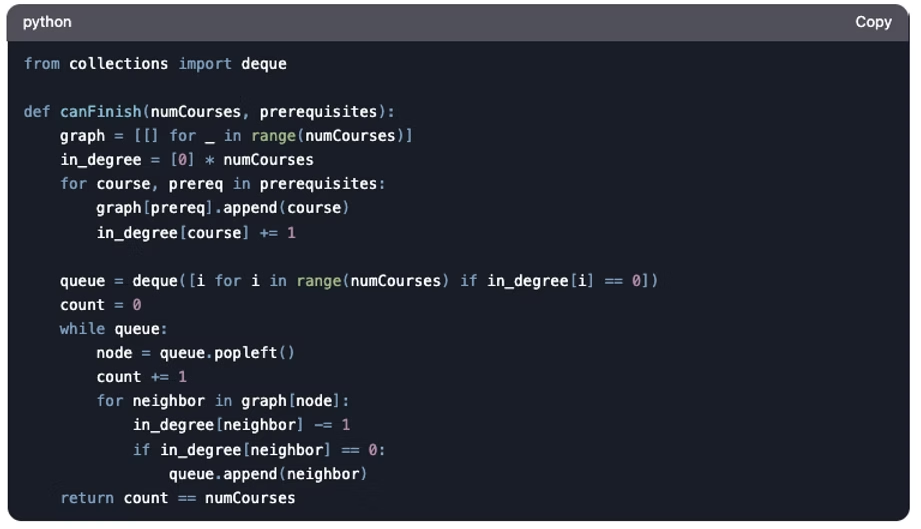
Complexity: Time - O(V + E), Space - O(V + E)
14. Number of Islands
Problem: Given a 2D grid of '1's (land) and '0's (water), count the number of islands.
Approach: Use DFS to explore connected land cells.
Solution:
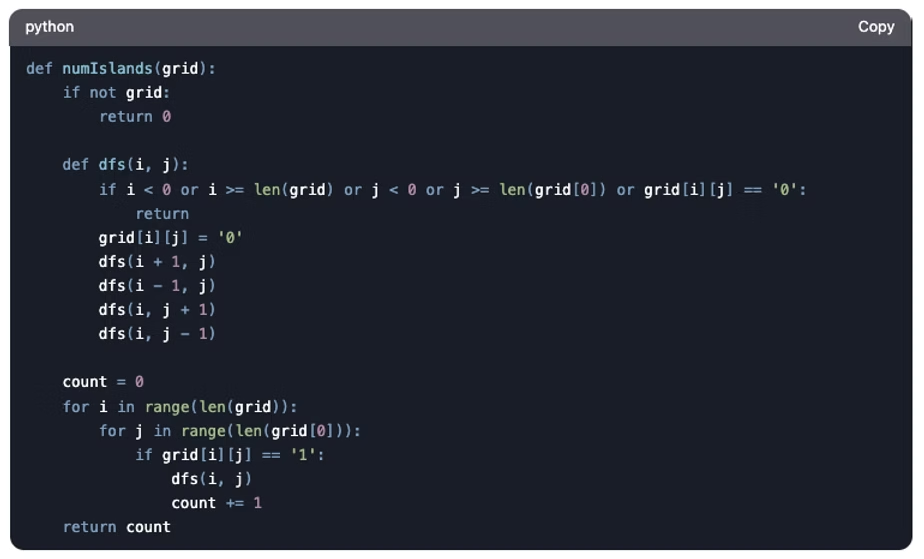
Complexity: Time - O(m n), Space - O(m n)
15. Rotate Image
Problem: Rotate a 2D matrix by 90 degrees clockwise.
Approach: Transpose the matrix and reverse each row.
Solution:

Complexity: Time - O(n^2), Space - O(1)
16. Binary Tree Right Side View
Problem: Given a binary tree, imagine yourself standing on the right side of it, return the values of the nodes you can see.
Approach: Use BFS and track the last node at each level.
Solution:
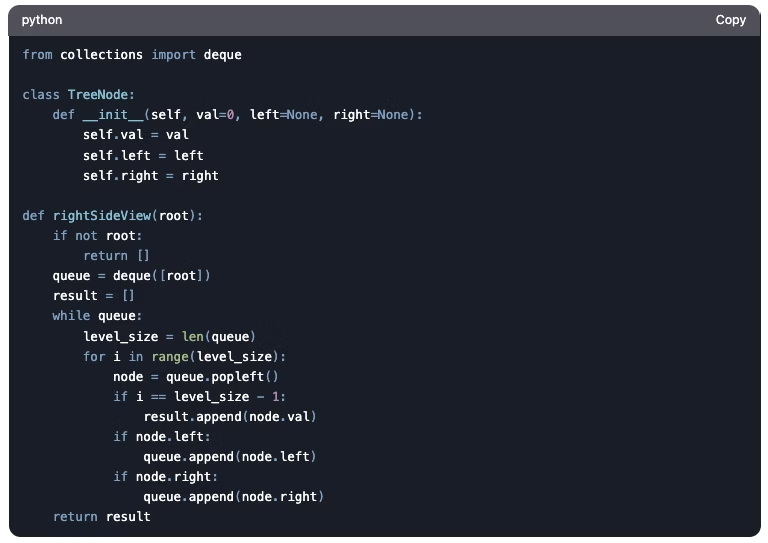
Complexity: Time - O(n), Space - O(n)
17. Longest Palindromic Substring
Problem: Find the longest palindromic substring in a string.
Approach: Use dynamic programming or expand around center.
Solution:

Complexity: Time - O(n^2), Space - O(1)
18. Serialize and Deserialize Binary Tree
Problem: Serialize a binary tree to a string and deserialize it back.
Approach: Use preorder traversal with a marker for null nodes.
Solution:
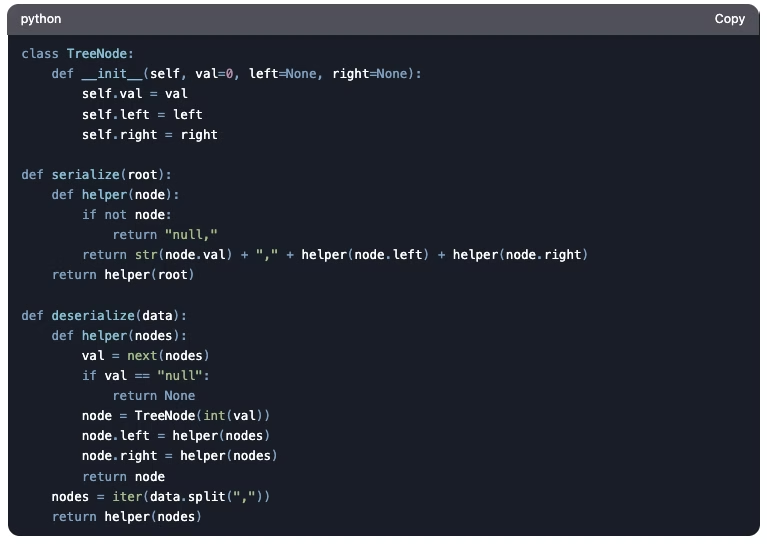
Complexity: Time - O(n), Space - O(n)
19. Minimum Window Substring
Problem: Find the minimum window in a string that contains all characters of another string.
Approach: Use a sliding window with two pointers.
Solution:
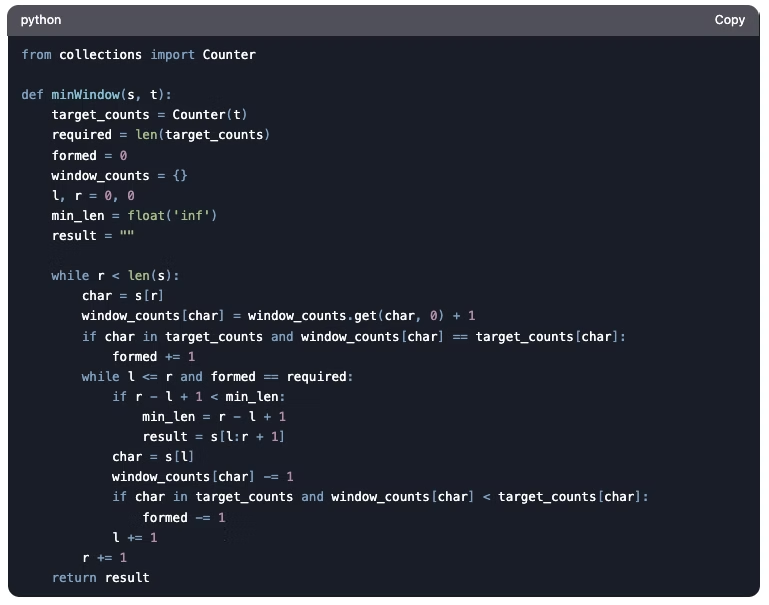
Complexity: Time - O(n), Space - O(n)
20. Edit Distance
Problem: Find the minimum number of operations (insert, delete, replace) to convert one string to another.
Approach: Use dynamic programming.
Solution:
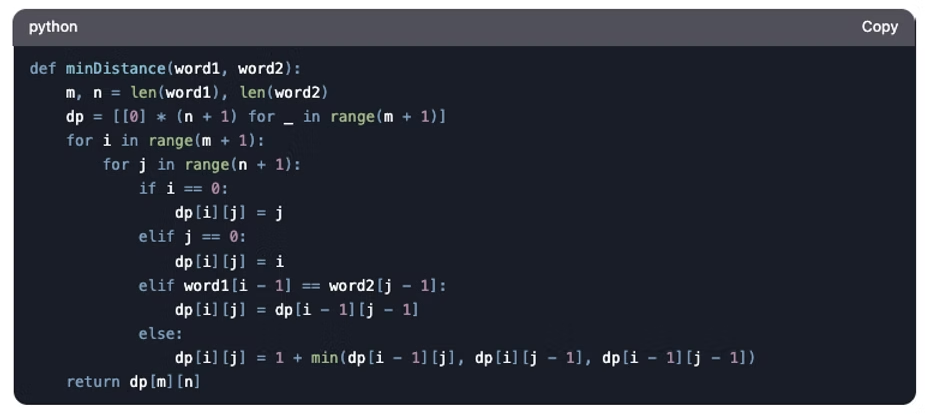
Complexity: Time - O(m n), Space - O(m n)
Strategies to Solve Coding Problems Efficiently
Now that you’ve seen the top 20 coding questions, let’s talk about strategies to tackle them:
Understand the Problem: Read the problem carefully and clarify doubts.
Break It Down: Identify subproblems and edge cases.
Choose the Right Data Structure: Use arrays, hash maps, or heaps as needed.
Write Pseudocode: Plan your solution before coding.
Optimize: Improve time and space complexity.
Test Edge Cases: Ensure your solution works for all scenarios.
How InterviewNode Can Help You Crack FAANG Interviews
Preparing for FAANG interviews can feel overwhelming. With so many concepts to master, coding problems to solve, and system design challenges to tackle, it’s easy to get lost in the sea of resources. That’s where InterviewNode comes in. We’ve built a platform specifically designed to help software engineers like you prepare effectively and confidently for FAANG interviews. Here’s how we can help:
1. Curated Coding Questions Tailored for FAANG
We know that FAANG interviews focus on specific types of coding problems. That’s why we’ve curated a library of 200+ coding questions that are frequently asked at FAANG companies. Each question comes with:
Detailed Problem Statements: Clear and concise explanations of what’s being asked.
Step-by-Step Solutions: Learn the most efficient approaches to solve each problem.
Sample Code: Get ready-to-use code snippets in Python, Java, and other popular languages.
Complexity Analysis: Understand the time and space complexity of each solution.
Our questions are categorized by difficulty (easy, medium, hard) and topic (arrays, trees, dynamic programming, etc.), so you can focus on the areas where you need the most practice.
2. Mock Interviews with FAANG-Level Difficulty
One of the best ways to prepare for FAANG interviews is to simulate the real experience. InterviewNode offers mock interviews that mimic the actual FAANG interview process. Here’s what you’ll get:
Realistic Interview Scenarios: Practice coding rounds, system design interviews, and behavioral questions.
FAANG-Level Problems: Tackle problems that are on par with what you’ll face at Google, Amazon, or Facebook.
Personalized Feedback: After each mock interview, you’ll receive detailed feedback on your performance, including areas for improvement.
Timed Practice: Get comfortable solving problems under time pressure, just like in a real interview.
Our mock interviews are conducted by experienced engineers who’ve been through the FAANG interview process themselves, so you’ll get insider tips and strategies.
3. Personalized Study Plans
We understand that every candidate is unique. That’s why InterviewNode creates personalized study plans based on your current skill level, target companies, and timeline. Here’s how it works:
Skill Assessment: Take a quick assessment to identify your strengths and weaknesses.
Customized Roadmap: Get a step-by-step plan that outlines what to study, how much time to spend on each topic, and when to take mock interviews.
Progress Tracking: Track your progress with detailed analytics and adjust your plan as needed.
Whether you’re starting from scratch or just need to polish your skills, our study plans will keep you on track.
4. System Design Mastery
System design is a critical part of FAANG interviews, especially for mid-to-senior roles. InterviewNode provides:
Comprehensive System Design Guides: Learn key concepts like scalability, load balancing, caching, and database sharding.
Real-World Examples: Practice designing systems like URL shorteners, ride-sharing apps, and recommendation engines.
Interactive Diagrams: Visualize your designs with our interactive tools and get feedback on your architecture.
Our system design resources are designed to help you think like a FAANG engineer and build scalable, efficient systems.
5. Behavioral Interview Preparation
FAANG companies don’t just care about your technical skills—they also want to see how you work in a team and handle challenges. InterviewNode helps you ace the behavioral interview with:
Common Behavioral Questions: Practice answering questions like “Tell me about a time you faced a challenge” or “How do you handle conflict?”
STAR Method Training: Learn how to structure your answers using the STAR (Situation, Task, Action, Result) method.
Mock Behavioral Interviews: Simulate real behavioral interviews and get feedback on your communication and storytelling skills.
We’ll help you showcase your personality, leadership skills, and cultural fit—qualities that FAANG companies value highly.
6. Affordable and Accessible
We believe that everyone should have access to high-quality interview preparation, no matter their budget. That’s why InterviewNode offers:
Flexible Pricing Plans: Choose from monthly or annual subscriptions to fit your needs.
Free Resources: Get started with free coding questions, system design guides, and behavioral tips.
Community Support: Join our community of aspiring FAANG engineers to share tips, ask questions, and stay motivated.
Conclusion
FAANG interviews are tough, but you don’t have to face them alone. InterviewNode is here to guide you every step of the way—from mastering coding problems to acing system design and behavioral interviews. Join thousands of successful candidates who’ve used InterviewNode to unlock their FAANG success.





